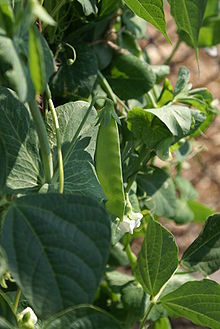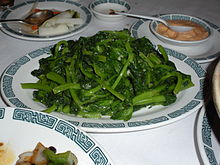- Snow pea
-
Snow pea Snow pea on the plant. Scientific classification Kingdom: Plantae (unranked): Angiosperms (unranked): Eudicots (unranked): Rosids Order: Fabales Family: Fabaceae
Lindl.Subfamily: Faboideae Genus: Pisum Species: Pisum sativum Variety: P. sativum var. saccharatum Trinomial name Pisum sativum var. saccharatum The snow pea (Pisum sativum var. saccharatum) is a legume, more specifically a variety of pea eaten whole in its pod while still unripe. The name mangetout (French for "eat all") can apply both to snow peas and to snap peas.
It is one of the earliest-known cultivated plants, with evidence of having been cultivated in a region that is now along the Thailand-Burma border, 12,000 years ago.[citation needed]
It is speculated that the name comes from the whitish tint reflected from the pods.[citation needed] It also may come because of their tendency to grow at the end of winter, just before the last spring freeze. They can be covered with snow - hence the name - during these times, but still keep growing well.[citation needed]
As with all legumes, snow peas host beneficial bacteria, rhizobia, in their root nodules, which fix nitrogen in the soil — this is called a mutualistic relationship — and are therefore a useful companion plant, especially useful to grow intercropped with green, leafy vegetables that benefit from high nitrogen content in their soil.
The green shoots can also be cut and served as a vegetable as is done in Chinese cooking, especially stir-fried with garlic or shellfish such as crab.[1]
Nutrition
See also
References
Categories:- Edible legumes
- Faboideae
- Chinese ingredients
- Faboideae stubs
- Chinese cuisine stubs
Wikimedia Foundation. 2010.


